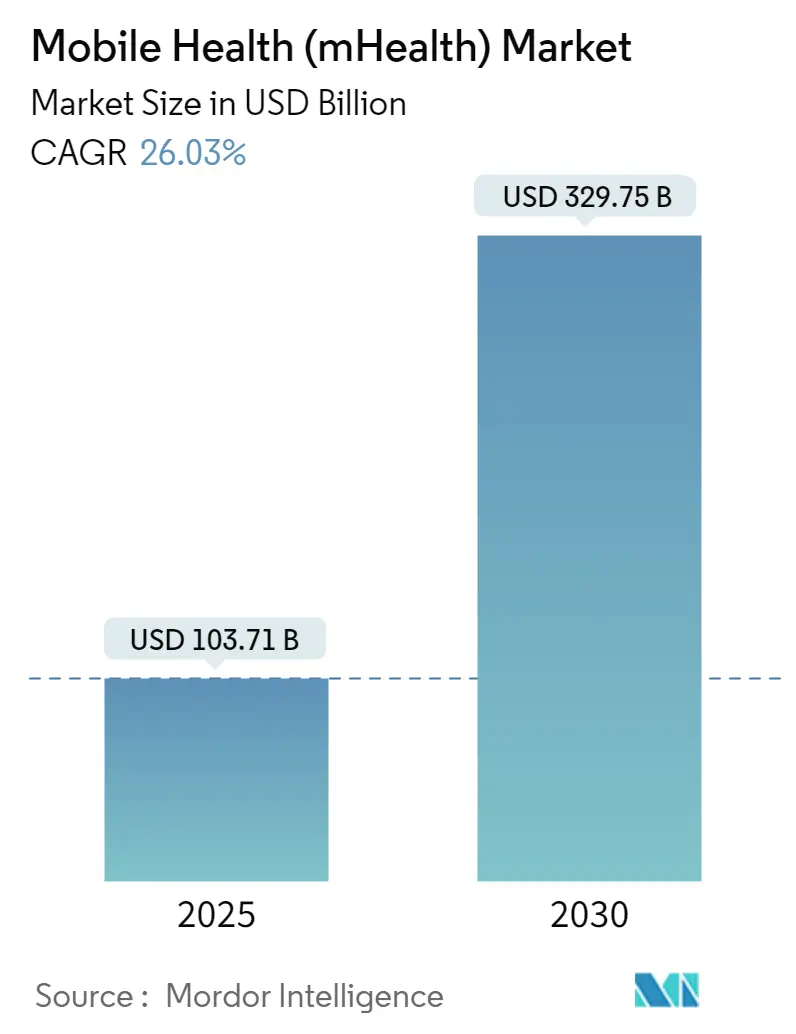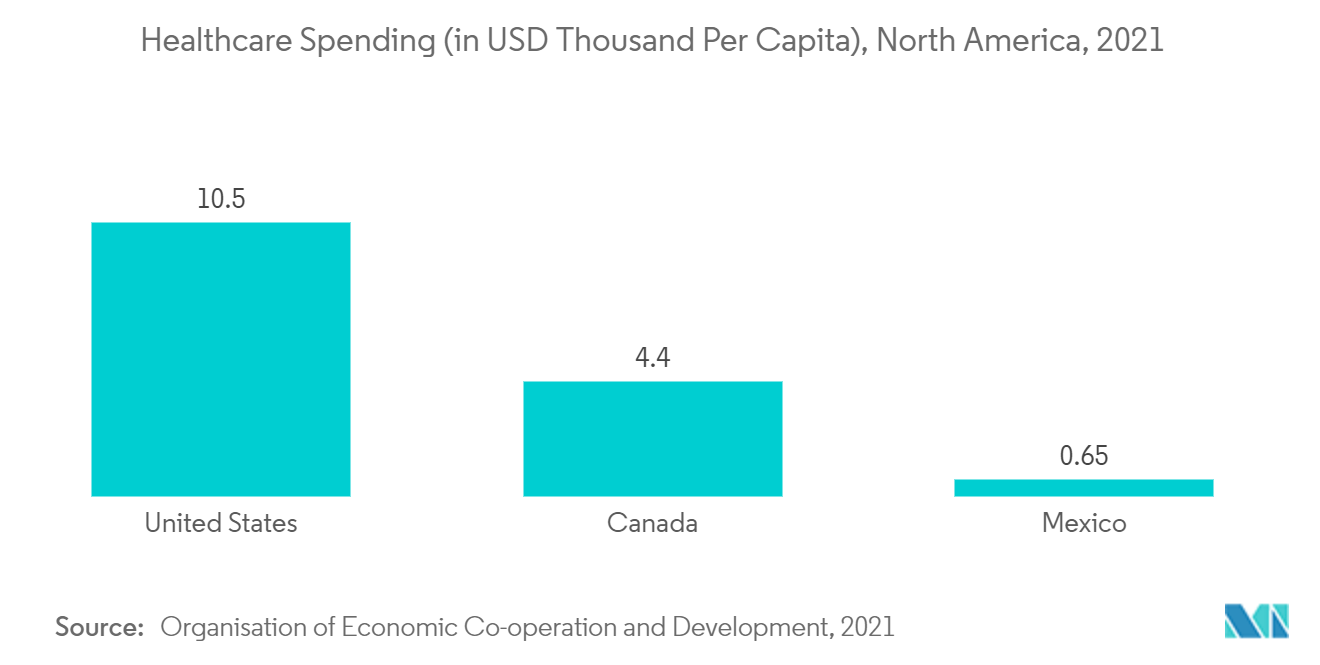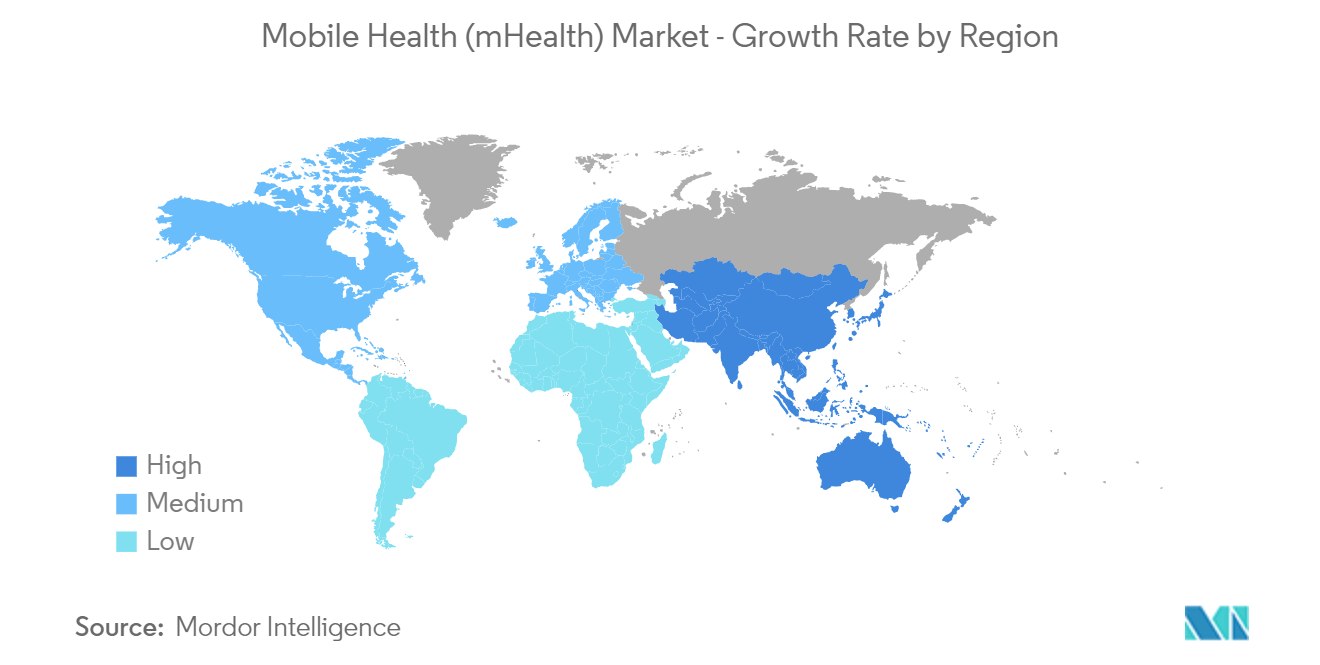mHealth Market Analysis
The Mobile Health Market size is estimated at USD 103.71 billion in 2025, and is expected to reach USD 329.75 billion by 2030, at a CAGR of 26.03% during the forecast period (2025-2030).
The COVID-19 pandemic had a relatively positive impact on the overall market. Mobile Health Solutions emerged as a new savior to avoid the further spread of infection and protect front-line workers and patients alike. Mobile Health Services, primarily through smartphones and Remote Patient Monitoring, became a lifeline for consultations. The primary factor was that many healthcare professionals took a two-way approach to treating patients. Therefore, the rising cases of COVID-19 increased the mobile health business in the short term. In the long run, this situation accelerated the wide adoption of digital solutions, especially those with remote care components. Before the pandemic, technology was on the back end in most hospitals, which created an opportunity to get in front by dealing with patients through online gateways. For instance, as per Becker's Healthcare Report, during the first three-quarters of 2021, there were 251 Digital Health Market investment deals. To improve the health of populations, Mobile Health Platforms have gained traction during the COVID-19 pandemic. The rising penetration of Digital Health Services for Remote Patient Monitoring is also increasing the demand for mobile health apps, even after the pandemic, which in turn is expected to propel mHealth Market Growth over the forecast period. Thus, the COVID-19 pandemic had an impact on the Mobile Health Market and is expected to do so in the long run.
The outbreak of the coronavirus boosted the usage of Telehealth and Mobile Health Solutions such as tele-ICU devices that helped the caregivers communicate effectively with their patients during the pandemic and provided better solutions to their health concerns. Due to social distancing implemented by various countries worldwide, virtual care delivery stepped up as an effective solution for safe and better communication.
In recent years, the number of internet applications in healthcare has increased exponentially. The internet has linked all the points in healthcare administration/services and created a separate network, the IoT, for healthcare. With the help of the internet, healthcare professionals can deliver health information to consumers more conveniently, in less time, and at a reduced cost. A growing preference for mobile technology and the internet and mounting demand for Digital Health is expected to boost the Mobile Health Industry growth.
Additionally, in August 2021, Athenahealth and the Smile Foundation launched the Smile on Wheels Mobile Healthcare Solutions program in Chennai. Athenahealth is providing financial support to a Smile on Wheels Mobile Health Unit, which will offer primary healthcare services in an area of Chennai with approximately 17,600 households and 88,000 residents. The Smile on Wheels is a national-level program catering to underprivileged children and women through Mobile Hospital Units. The program sends medical vans along with specialized doctors, nurses, medical staff, and medicine to identified villages and underserved communities to provide crucial access to healthcare services.
Thus, owing to the abovementioned factors, the mHealth Market is expected to show growth over the forecast period. However, data security issues and stringent regulatory scenarios for Mobile Health Applications may hamper the growth of the market.
mHealth Market Trends
Remote Patient Monitoring Devices are Expected to Show Better Growth Over the Forecast Period
Mobile Health Solutions for monitoring and collecting real-time patient data play a critical role in managing various vital parameters of the patients for better health outcomes. The wearable device allows the patient information to be easily tracked and verified by the concerned doctor and grounds the result analysis for treatment services. If the patient's abnormal condition is found in the eHealth monitoring system (EHMS) analysis, the doctor can make appropriate decisions based on the results. Treatment can be started immediately, and relevant medication setups can be sent to the patient in an ambulance within a short time.
Through SMS services, Remote Patient Monitoring Platforms help to provide various additional health-related services, such as daily health alerts, doctor appointments, eHealth check-up reports, suggested food diets, and other benefits. Consequently, hospitals can customize EHMS applications and provide the best possible eHealth Services.
Furthermore, the approval of products by market players is propelling the growth of the market segment. For instance, in November 2021, AirStrip announced the formation and integration of its platform with Adjuvare, Inc. The creation of the inter-operative and AI-augmented Adjuvare platform will extend acute and semi-acute patient care from the hospital to the patient's home with the establishment of "NORAD" of Virtual Acute Care.
Additionally, in November 2022, the company launched Mobile Health Applications PharmcoMyRPM, a mobile app and patient portal, and PharmcoRPM, a web portal, to help providers remotely manage patients' chronic disease and transitional care.
Thus, owing to the increasing product approvals for continuous monitoring of vital parameters and the growing awareness of health management, the mHealth Market segment is expected to grow over the forecast period.
North America is Expected to Dominate the Mobile-Health (m-Health) Market Over the Forecast Period
North America is projected to maintain its dominance in the Mobile Health (mHealth) Market over the forecast period. The increasing geriatric population, rising incidences of chronic diseases, growing demand for wireless and portable systems, and the presence of sophisticated reimbursement structures aimed at cutting out-of-pocket expenditure levels are the major factors attributed to its large market share.
Due to the outbreak of COVID-19 in the United States and the lockdown situation, it was also essential to maintain core and critical medical and public health services. Telemedicine Services widely increased in the country, as per the CDC, thereby significantly driving the market. As per the study published in June 2021, there are about 2,000 mobile clinics in the United States, serving 7 million at-risk people annually. The mobile clinic model is an efficient avenue for Mobile Healthcare delivery (USD 36 saved from mobile clinic services compared to emergency room visits for every USD 1 invested in the mobile clinic). Thus, the increasing market for Mobile Health Services is expected to boost the growth of the overall market throughout the analysis period.
Moreover, healthcare in the North American region is experiencing positive trends with the emergence of Mobile Health Applications that help people be active in personal health management. Smartphones and mobile technology make it possible to use both clinical and lifestyle applications to support, educate, and change health behaviors. More people are now using Mobile Health Applications.
The technological advancements in Mobile Medical Devices, product launches, partnerships, and acquisitions are projected to boost the market's growth. For instance, in January 2021, Boston Scientific Corporation acquired Preventice Solutions, a privately held company that provides a full range of Mobile Cardiac Health Solutions and services, including ambulatory cardiac monitors like short- and long-term Holter monitors, cardiac event monitors, and mobile cardiac telemetry. Additionally, in February 2021, Philips acquired BioTelemetry Inc., one of the leading United States-based remote cardiac diagnostics and monitoring service providers.
Thus, owing to the abovementioned factors, the market in the North American region is expected to project growth over the forecast period.
mHealth Industry Overview
The Mobile Health Industry is fairly competitive. Market players focus on new product launches, such as essential cardiology and blood glucose monitors. Moreover, smartwatches, health monitors, pedometers, and activity trackers are smart wearable devices launched by several companies. The key mHealth Vendors in the market are Medtronic PLC, Cisco Systems, Inc., Koninklijke Philips N.V., Johnson & Johnson, and Samsung, among others.
mHealth Market Leaders
-
Medtronic PLC
-
Cisco Systems, Inc.
-
Koninklijke Philips N.V.
-
Johnson & Johnson
-
Samsung
- *Disclaimer: Major Players sorted in no particular order
mHealth Market News
- August 2022: Kaiser Permanente of the Northwest and Medical Teams International launched an innovative initiative, namely Kaiser Permanente Care & Connect, that will provide mobile healthcare services to marginalized populations throughout the Pacific Northwest.
- June 2022: Orange Health launched its diagnostic services in New Delhi, India, as part of its ambitious geographical expansion plan. With this launch, customers across the NCR region can avail of a wide range of diagnostic services in just 60 minutes from the comfort of their homes, with reports in six hours.
mHealth Industry Segmentation
As per the scope of the report, the National Institutes of Health (NIH) defined mHealth as the use of mobile and wireless devices (that includes cell phones, tablets, etc., patient monitoring devices, and personal digital assistants (PDAs)) to improve health outcomes, health care services, and health research. The mobile health (mHealth) market is segmented by service type (treatment services, diagnostic services, monitoring services, wellness and fitness solutions, and other services), device type (blood glucose monitors, cardiac monitors, hemodynamic monitors, neurological monitors, respiratory monitors, body and temperature monitors, remote patient monitoring devices, and other device types), stakeholder (mobile operators, healthcare providers, application/content players, and other stakeholders), and geography (North America, Europe, Asia-Pacific, Middle East and Africa, and South America). The market report also covers the estimated market sizes and trends for 17 countries across major global regions. The report offers the value (USD million) for the abovementioned segments.
| By Service Type | Treatment Services | Independent Aging Solutions | |
| Chronic Disease Management | |||
| Diagnostic Services | |||
| Monitoring Services | Remote Patient Monitoring Devices | ||
| Medical Call Centers Manned by Healthcare Professionals | |||
| Teleconsultation | |||
| Post Acute Care Services | |||
| Wellness and Fitness Solutions | |||
| Other Services | |||
| By Device Type | Blood Glucose Monitors | ||
| Cardiac Monitors | |||
| Hemodynamic Monitors | |||
| Neurological Monitors | |||
| Respiratory Monitors | |||
| Body and Temperature Monitors | |||
| Remote Patient Monitoring Devices | |||
| Other Device Types | |||
| By Stake Holder | Mobile Operators | ||
| Healthcare Providers | |||
| Application/Content Players | |||
| Other Stake Holders | |||
| Geography | North America | United States | |
| Canada | |||
| Mexico | |||
| Europe | Germany | ||
| United Kingdom | |||
| France | |||
| Italy | |||
| Spain | |||
| Rest of Europe | |||
| Asia-Pacific | China | ||
| Japan | |||
| India | |||
| Australia | |||
| South Korea | |||
| Rest of Asia-Pacific | |||
| Middle East and Africa | GCC | ||
| South Africa | |||
| Rest of Middle East and Africa | |||
| South America | Brazil | ||
| Argentina | |||
| Rest of South America | |||
mHealth Market Research FAQs
How big is the Mobile Health Market?
The Mobile Health Market size is expected to reach USD 103.71 billion in 2025 and grow at a CAGR of 26.03% to reach USD 329.75 billion by 2030.
What is the current Mobile Health Market size?
In 2025, the Mobile Health Market size is expected to reach USD 103.71 billion.
Who are the key players in Mobile Health Market?
Medtronic PLC, Cisco Systems, Inc., Koninklijke Philips N.V., Johnson & Johnson and Samsung are the major companies operating in the Mobile Health Market.
Which is the fastest growing region in Mobile Health Market?
Asia Pacific is estimated to grow at the highest CAGR over the forecast period (2025-2030).
Which region has the biggest share in Mobile Health Market?
In 2025, the North America accounts for the largest market share in Mobile Health Market.
What years does this Mobile Health Market cover, and what was the market size in 2024?
In 2024, the Mobile Health Market size was estimated at USD 76.71 billion. The report covers the Mobile Health Market historical market size for years: 2019, 2020, 2021, 2022, 2023 and 2024. The report also forecasts the Mobile Health Market size for years: 2025, 2026, 2027, 2028, 2029 and 2030.
Our Best Selling Reports
mHealth Industry Report
The global mHealth market is experiencing significant growth, driven by the increased adoption of mobile health technologies and applications. This market expansion is fueled by the rising prevalence of chronic diseases and the growing demand for remote patient monitoring. The heightened awareness of mHealth solutions among patients and healthcare providers is also a critical factor in this growth.
The mHealth market thrives on innovation, offering a wide range of applications from disease management to wellness. Key segments such as mHealth apps, monitoring services, and mobile operators are expanding due to the widespread use of smartphones and internet access. Favorable government policies and strategic industry collaborations are supporting this market's promising expansion.
Despite challenges like privacy concerns, the mHealth market is overcoming these obstacles through technological advancements and a focus on personalized healthcare. The market size and market report indicate robust growth, with detailed industry analysis and market research providing valuable insights. The market share of various segments highlights the competitive landscape, while the global market trends showcase the industry's trajectory.
Industry reports and market analysis reveal a comprehensive market overview, including market forecast and market growth predictions. The industry outlook and market review offer a detailed examination of market segmentation and market value. Industry statistics and market data further support the market's potential, with industry trends and market predictions indicating sustained growth.
For those seeking more detailed information, industry research and report pdf downloads provide in-depth insights. Research companies and industry information are essential for understanding the market leaders and their strategies. The industry size and industry sales reflect the market's economic impact, while the market outlook and market overview offer a glimpse into future developments.
In summary, the mHealth market is set for continued growth, driven by technological advancements and a focus on personalized healthcare. The market's expansion is supported by comprehensive industry analysis, market data, and detailed industry reports, providing a clear picture of the market's potential and future trajectory.

_Market_1.webp)



_Market.webp)

